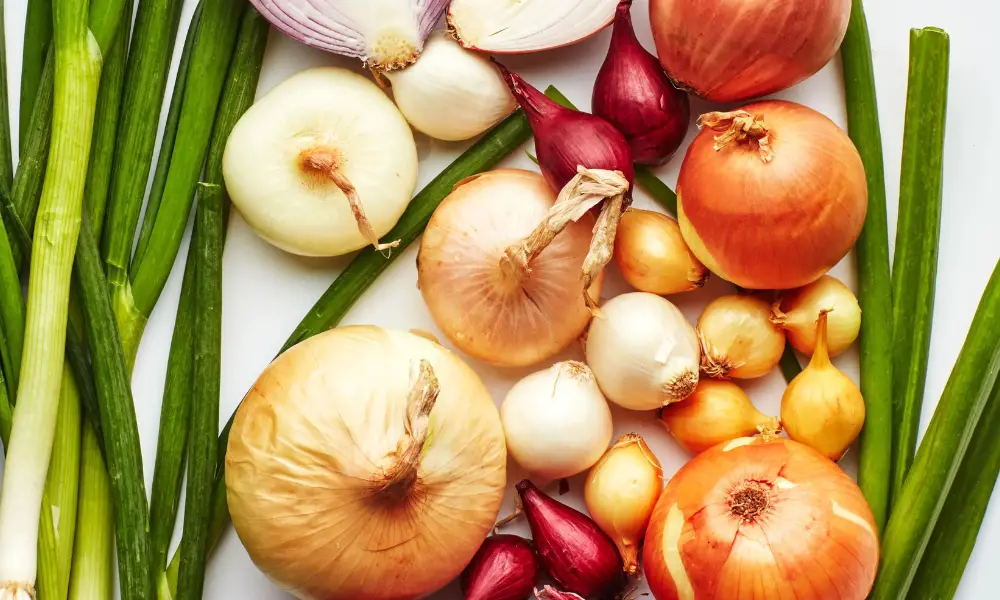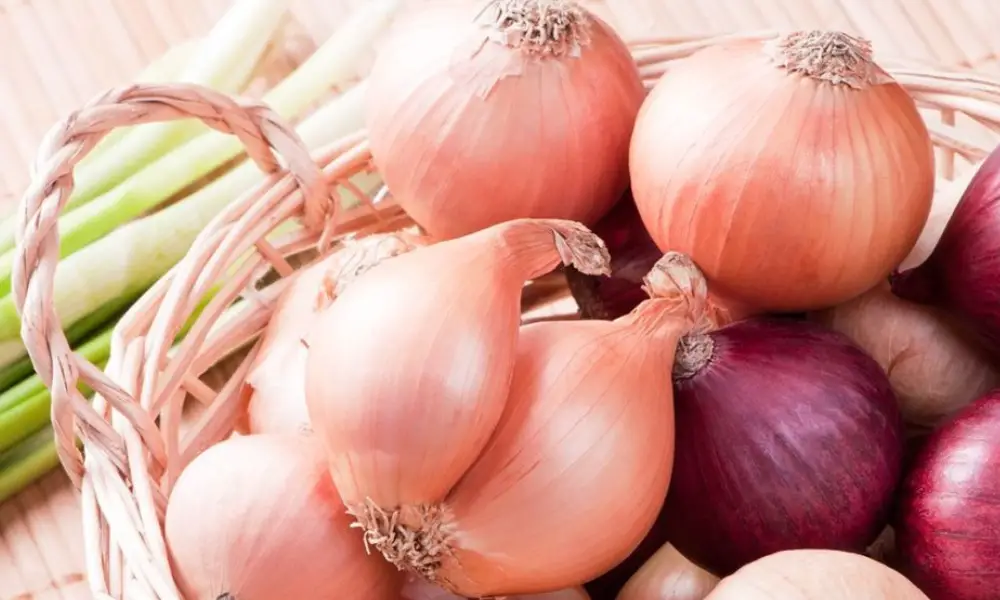Have a large number of onions from a bulk buy or your garden? They will last for several months if you use the right storage method. Even chopped onions will keep for a long time if they are stored properly. The following information will help you extend the shelf life of your onions.
When storing onions, there are three basic options. These include storing them in the fridge, airtight container, or at room temperature. Sliced or chopped onions should be stored at room temperature. Onions can be stored for several months. Read on to learn more about storage for onions.

What is the Best Way to Store Onions
Sweet Onions in Storage
Early summer harvests of sweet onions have a high moisture content and are therefore difficult to store. Use different types of onions initially if you have them available. The National Onion Association advises wrapping each sweet onion in a paper towel and storing them in your refrigerator to prolong their storage life. 1 Even if you do this, you should still use your sweet onions right away because the moisture in them makes them susceptible to mold. If you notice mold, discard your onions (or compost them) right away.
Dry Bulb Onion Storage
The sour onions that are harvested in the late summer and early fall can be kept for months in storage. They are preserved by the sulfurous compounds in them (the thing that makes you cry when you cut them). Your dry bulb onions should be kept in a cool, dry, well-ventilated area to extend their storage life. They need to be allowed to breathe, so avoid keeping them in plastic bags. Here’s a quick and easy method for keeping dry onions fresh:
You will require a pantyhose.
Check all of the onions for mold, mushy patches, or other damage indicators. Only flawless onions can be kept for a long time. Use them right now if they are growing rather than considering keeping them.
Legs from a fresh pair of pantyhose should be severed.
Place an onion in the first leg’s foot and secure it with a knot.
To fill both legs, keep adding onions and making knots.
Hang the tights somewhere cool and dry (a location with a temperature between 40-45 F is ideal).
Simply slit one of the portions that have been tied off when you need an onion.
This will enable you to keep using the pantyhose. The next time, simply insert an onion through the incision into the area.
Storage Advice for Dry Bulb Onions
Cure the onions before keeping them if they were grown at home. If not, they’ll start to mold.
Keep onions away from other veggies when stored. The flavor of the onion will be absorbed by many fruits and vegetables.
Long braids or mesh sacks can also be used to keep onions.
Your onions should keep for up to eight months if stored properly. To prevent the rest of the onions from going bad, check them frequently and throw away any that seem to be going bad.
How to Select the Storage Onion Variety to Grow?
The majority of storage onions are long-day types, which means they need at least 14 hours of sunshine per day to develop healthily. They are therefore most suited for growing in northern states. Select a Red Bull or other short-day variety if you reside in the south. You’ll be considerably more pleased with the outcomes.
As you can see from the list, there are a lot more options for yellow storage onions than red or white ones, but you can surely plant a mixture. Many gardeners choose to produce a variety of keeping onions because some have a longer shelf life than others. They then just use the ones with the shortest shelf life first.
This is a clever approach to make sure you have enough onions to last you until the harvest the following year.
So that they are well established before the hot season arrives, plant your onions as soon as the ground is suitable for cultivation. As a general rule, plant your onions outside while you start the rest of your seeds inside.
What are the Different Varieties of Onions and their Uses?
A Fine Cuisine
The fact that every cuisine on earth uses onions proves that they are a luxury despite the fact that they are numerous, inexpensive, and can grow just about anywhere.
One of the most adaptable and often used items in cooking, onions can be roasted, grilled, pickled, caramelized, battered and deep-fried, thinly sliced or chopped, and served raw in salads, sandwiches, dips, or as a garnish for tacos.
One-third of the classic mirepoix, often known as the “holy trinity” of Cajun cooking or the Italian soffritto, is made up of onions. This fundamental combination of onions, carrots, and celery is used to improve the flavor of soups, stocks, and sauces (which substitute bell peppers for carrots).
Garlic, chives, shallots, leeks, and onions are all members of the Allium genus. The shoots and the bulb can both be eaten. An eye-irritating sulfur-based vapor is released when cutting onions.
China grows the most onions of any nation in the world, yet with 1.3 billion people to feed, they must consume the majority of their harvest. It’s interesting to note that the Netherlands is the leading exporter of onions worldwide.
Yellow Onions
Yellow onions are the workhorse, the standard, and the everyday brown beauty. They may be used for any imaginable purpose, with the possible exception of perhaps as a garnish for your martini (use pearl onion for that). Even if this were the only onion you ever tasted, you could still lead a wealthy and fulfilled life.
Its creamy white flesh is encased in a thick, brown parchment skin with a strong, sulfurous fragrance. If a recipe calls for onions but doesn’t specify the kind, yellow onions are taken as a given. Make French onion soup with them.
Sweet Onions
Sweet onions have skin that is less opaque, lighter in color, and flatter than yellow onions. They also have more sugar than yellow onions, which makes them ideal for caramelizing. They are perfect for making onion rings because of their bigger size and sweeter flavor. Walla Walla, Maui, Vidalia, as well as other types with the term “sweet” in the name, are examples of sweet onion varieties.
White Onions
White onions are excellent for serving raw in homemade guacamole or fresh salsa since they have a papery white exterior and a milder, sweeter flavor than yellow onions.
Red Onion
Red onions are particularly ideal additions to salads or anywhere else a splash of color will enhance the aesthetic of the food because both the external skin and the meat are sweet and mild enough to be eaten raw. I adore putting red onions on burgers, sandwiches, and salads.
Leeks are a very wonderful vegetable that is regrettably underrated. Leeks, which resemble large scallions, are great in soups and sauces. One of our favorite ways to prepare them is à la gratinée, which involves baking them and then topping them with Gruyère cheese and seasoned breadcrumbs. The leeks get softer and lose some of their flavors when baked.
Reference: Descriptions of types of principal American varieties of onions
How are Onions Frozen?
The crispness of chopped or sliced onions will be lost once they are frozen and used in recipes, but you can keep them for subsequent use. They work well in pre-made recipes as a result. You’ll probably be unsatisfied if you consume them uncooked. To freeze onions, chop or slice them into the desired size (do not freeze them whole). Then, spread them out on a sheet pan and quickly freeze them. Squeeze out as much air as you can before transferring your frozen onions to a freezer bag.
To prevent the scent of onions from permeating the rest of your refrigerator and freezer, it is preferable to freeze a lot of onions in batches. Many frozen items will easily pick up this odor and flavor because their odor will be strong until they are frozen when it won’t be noticeable.
What Sort of Onion Is Suitable for Spaghetti?
You can use high sugar content, well-caramelized white or yellow onions. Fresh garlic is best, but if you’re in a hurry, chopped garlic from a can will do. Olive oil gives your sauce richness and depth. Yellow onions are the most popular type to use in cooking and have thick, brownish-yellow skin with thin layers of white flesh. They are astringent and have a strong, almost peppery flavor that onions are known for and are high in sugar.
How to Increase the Shelf Life of Onions?
Follow a few simple but useful ways to extend the time that onions are usable for cooking so that you can continue to enjoy this vegetable at home.
Onions prefer cool, dark environments, such as in the cellar. Put onions in the refrigerator if you don’t have one in your home or flat.
Wrap your onions in loose paper or store them in a mesh bag or basket to extend their shelf life. It will allow for appropriate air circulation and prevent the vegetables from quickly going bad.
Never store onions in plastic bags since the lack of oxygen will cause the veggie to rot.
Because potatoes will spoil more quickly if the onion is allowed to “live” nearby, it is advisable to prevent this from happening.
Never store onions next to any fresh fruit, even watermelons. The explanation is straightforward: Fruits release a particular gas that hastens the rotting and deteriorating of vegetables.
Conclusion
When storing onions, it is important to keep in mind the temperature and humidity levels. Onions can rot and sprout when stored in high temperatures or humidity. For best results, onions should be stored between 40 and 50degF and in a dark, cool cupboard. For longer-term storage, a wire-mesh basket or perforated plastic bin is recommended. Alternatively, a freezer bag or an airtight container may be used.
Although it may seem counter-intuitive, storing onions in an airtight container is an excellent way to extend their life. However, it is not a good idea to store raw, unpeeled onions in an airtight container. Onions that are chopped, or already peeled and stored in a resealable plastic bag, are best kept in the refrigerator. They will keep for seven to ten days if stored properly, while sliced onions can be stored for two to three weeks.

